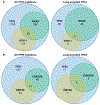Lung-Enriched Mutations in the p53 Tumor Suppressor: A Paradigm for Tissue-Specific Gain of Oncogenic Function
- PMID: 30224539
- PMCID: PMC6729127
- DOI: 10.1158/1541-7786.MCR-18-0357
Lung-Enriched Mutations in the p53 Tumor Suppressor: A Paradigm for Tissue-Specific Gain of Oncogenic Function
Abstract
Lung cancer, the leading cause of cancer-related mortality in the United States, occurs primarily due to prolonged exposure to an array of carcinogenic compounds in cigarette smoke. These carcinogens create bulky DNA adducts, inducing alterations including missense mutations in the tumor suppressor gene TP53 TP53 is the most commonly mutated gene in many human cancers, and a specific set of these variants are enriched in lung cancer (at amino acid residues V157, R158, and A159). This perspective postulates that lung-enriched mutations can be explained, in part, by biological selection for oncogenic gain-of-function (GOF) mutant p53 alleles at V157, R158, and A159. This hypothesis explaining tissue-specific TP53 mutations is further supported by mouse model studies of the canonical TP53 hotspots showing that tumor spectra and GOF activities are altered with mutation type. Therefore, although smoking-related lung cancer unequivocally arises due to the mutagenic environment induced by tobacco carcinogens, this perspective provides a rationale for the preferential selection of lung-enriched V157, R158, and A159 mutant p53.
©2018 American Association for Cancer Research.
Conflict of interest statement
Conflict of interest disclosure statement:
The authors have no conflicts of interest to disclose.
Figures


Similar articles
-
The lung-enriched p53 mutants V157F and R158L/P regulate a gain of function transcriptome in lung cancer.Carcinogenesis. 2020 Mar 13;41(1):67-77. doi: 10.1093/carcin/bgz087. Carcinogenesis. 2020. PMID: 31067569 Free PMC article.
-
Somatic p53 mutations that are markedly overrepresented in lung cancer confer resistance to reactive oxygen species-induced cell death.Carcinogenesis. 2025 Apr 3;46(2):bgaf027. doi: 10.1093/carcin/bgaf027. Carcinogenesis. 2025. PMID: 40458924
-
Molecular alterations and lung tumors in p53 mutant mice exposed to cigarette smoke.Cancer Res. 2003 Feb 15;63(4):793-800. Cancer Res. 2003. PMID: 12591728
-
Harnessing the vulnerabilities of p53 mutants in lung cancer - Focusing on the proteasome: a new trick for an old foe?Cancer Biol Ther. 2020 Apr 2;21(4):293-302. doi: 10.1080/15384047.2019.1702403. Epub 2020 Feb 10. Cancer Biol Ther. 2020. PMID: 32041464 Free PMC article. Review.
-
Smoking, p53 mutation, and lung cancer.Mol Cancer Res. 2014 Jan;12(1):3-13. doi: 10.1158/1541-7786.MCR-13-0539. Mol Cancer Res. 2014. PMID: 24442106 Free PMC article. Review.
Cited by
-
The lung-enriched p53 mutants V157F and R158L/P regulate a gain of function transcriptome in lung cancer.Carcinogenesis. 2020 Mar 13;41(1):67-77. doi: 10.1093/carcin/bgz087. Carcinogenesis. 2020. PMID: 31067569 Free PMC article.
-
Insights into Allosteric Mechanisms of the Lung-Enriched p53 Mutants V157F and R158L.Int J Mol Sci. 2022 Sep 3;23(17):10100. doi: 10.3390/ijms231710100. Int J Mol Sci. 2022. PMID: 36077492 Free PMC article.
-
LKB1/AMPK Pathway and Drug Response in Cancer: A Therapeutic Perspective.Oxid Med Cell Longev. 2019 Oct 31;2019:8730816. doi: 10.1155/2019/8730816. eCollection 2019. Oxid Med Cell Longev. 2019. PMID: 31781355 Free PMC article. Review.
-
Case report: Fatal hemoptysis after effective treatment with tislelizumab and anlotinib in pulmonary sarcomatoid carcinoma.Front Oncol. 2024 Sep 30;14:1445358. doi: 10.3389/fonc.2024.1445358. eCollection 2024. Front Oncol. 2024. PMID: 39403337 Free PMC article.
-
Advanced Strategies for Therapeutic Targeting of Wild-Type and Mutant p53 in Cancer.Biomolecules. 2022 Apr 6;12(4):548. doi: 10.3390/biom12040548. Biomolecules. 2022. PMID: 35454137 Free PMC article. Review.
References
-
- Lane DP, Crawford LV. T antigen is bound to a host protein in SV40-transformed cells. Nature 1979;278:261–3 - PubMed
-
- Linzer DI, Levine AJ. Characterization of a 54K dalton cellular SV40 tumor antigen present in SV40-transformed cells and uninfected embryonal carcinoma cells. Cell 1979;17:43–52 - PubMed
Publication types
MeSH terms
Substances
Grants and funding
LinkOut - more resources
Full Text Sources
Other Literature Sources
Medical
Molecular Biology Databases
Research Materials
Miscellaneous

